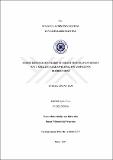Please use this identifier to cite or link to this item:
http://hdl.handle.net/11547/2212Full metadata record
| DC Field | Value | Language |
|---|---|---|
| dc.contributor.author | Çaltılı, Emrah | - |
| dc.date.accessioned | 2019-05-27T06:04:35Z | - |
| dc.date.available | 2019-05-27T06:04:35Z | - |
| dc.date.issued | 2017 | - |
| dc.identifier.uri | http://hdl.handle.net/11547/2212 | - |
| dc.description.abstract | Deprem sonrası meydana gelen hasarların en önemli nedenlerinden biri olan zemin sıvılaşması, kohezyonsuz ve suya doygun kumlu, siltli zeminlerde tekrarlı ve geçici yükler altında meydana gelmektedir. Bu çalışma Edirne ili ve çevresinin sıvılaşma potansiyelinin değerlendirilmesini içermektedir. Kuzey Anadolu Fay Hattı veya Edirne çevresindeki oluşabilecek bir depremde Edirne İlinin de etkilenebileceği düşünülmektedir. Bu sebeple Edirne ilinin sıvılaşma potansiyeli standart penetrasyon deneyi (SPT) ve laboratuvar verileri kullanılarak araştırılmıştır. Edirne ili ve ilçelerinde toplam 77 adet sondaj kuyusu açılmış ve standart penetrasyon deneyi(SPT) yapılmıştır. Sondaj kuyularından örselenmiş ve örselenmemiş zemin numuneleri alınmış, bu numuneler üzerinde zeminin fiziksel ve mekanik özelliklerini belirlemek amacıyla deneyler yapılmıştır. Sıvılaşma potansiyeli analizleri bugüne kadar Seed ve Idriss (1971), ‘Youd (2001), Rouch (1998)’ Wang(1979), Dorby ve diğ. (1992) gibi araştırmacılarının yöntemleriyle incelenmiştir. Idriss & Boulanger’ın 2008-2010 yılında yapmış olduğu çalışması araştırmalara dahil edilmemiş olması nedeniyle bu tezde bu yayın öncü alınmış ve bu yöntemi kullanan LiqSVs programı analizler için kullanılmıştır. Çalışmanın son aşamasında farklı deprem büyüklük senaryoları düşünülüp artan sismik aktivite ve odak derinliği ile beraber sıvılaşma potansiyelinin nasıl etkileneceği tartışılmıştır. | tr_TR |
| dc.language.iso | tr | tr_TR |
| dc.publisher | İSTANBUL AYDIN ÜNİVERSİTESİ FEN BİLİMLERİ ENSTİTÜSÜ | tr_TR |
| dc.subject | Sıvılaşma | tr_TR |
| dc.subject | Standart Penetrasyon (SPT) | tr_TR |
| dc.subject | Edirne | tr_TR |
| dc.subject | Sıvılaşma Analizi | tr_TR |
| dc.subject | LiqSvs | tr_TR |
| dc.subject | Liquefaction | tr_TR |
| dc.subject | Standart Penetration Test | tr_TR |
| dc.subject | Edirne | tr_TR |
| dc.subject | Liquefaction Analysis | tr_TR |
| dc.subject | LiqSvs | tr_TR |
| dc.title | EDİRNE İLİNDEKİ ZEMİNLERİN STANDART PENETRASYON DENEYİ (SPT ) KULLANILARAK SIVILAŞMA POTANSİYELİNİN BELİRLENMESİ | tr_TR |
| dc.type | Thesis | tr_TR |
| dc.description.abstractol | One of the most important causes of damages after the earthquake is the liquefaction of the ground, which occurs under repeated and transient loads oncohesionless and watery saturated sandy or silty soils. This study includes evaluation of the liquefaction potential of Edirne province and its surroundings. It is thought that Edirne Province may also be affected in an earthquake that may occur at the North Anatolian Fault Line or a possible earthquake around surroundings of Edirne. Therefore, the liquefaction potential of Edirne province have been investigated using standard penetration tests (SPT) and relevant laboratory data. A total number of 77 borehole were opened in Edirne province and districts, followed by standard penetration tests (SPT) to obtain desired characteristics. Remolded and undisturbed soil samples were extracted from boreholes and corresponding experiments were conducted to obtain physical and mechanical properties of the soil. Methods used for analysis of liquefaction potential have been carried out by researchers like Seed and Idriss (1971), Youd (2001), Rouch (1998), Wang (1979) and Dorby et al.(1992). Since the work of Idriss & Boulanger in 2008-2010 was not included in previous studies, this publication was taken as a pioneer and the LiqSVs program using this method was used for analysis.In the last phase of the study, different earthquake magnitude scenarios are being considered and how the potential of liquefaction will be affected with increasing seismic activity and depth of focus is presented. | tr_TR |
| dc.publisher.firstpagenumber | 1 | tr_TR |
| dc.publisher.lastpagenumber | 78 | tr_TR |
| Appears in Collections: | Tezler -Thesis | |
Files in This Item:
| File | Description | Size | Format | |
|---|---|---|---|---|
| 477630.pdf | 12.02 MB | Adobe PDF |  View/Open |
Items in DSpace are protected by copyright, with all rights reserved, unless otherwise indicated.
